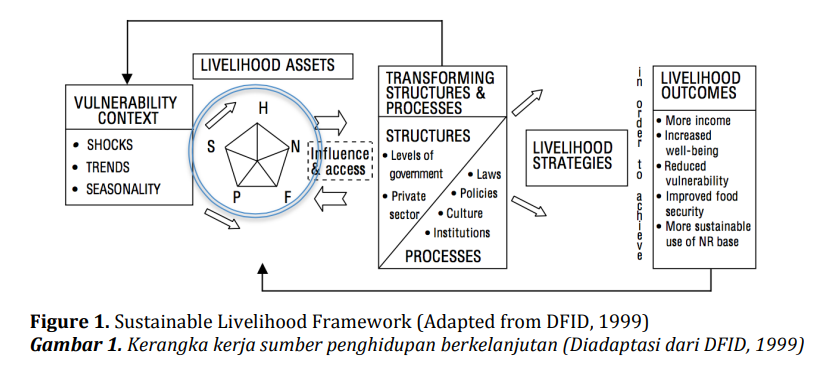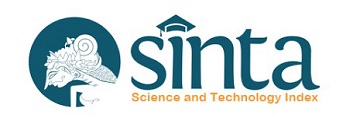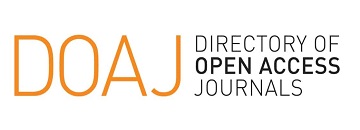Analysis of wild honey development policy for local people livelihoods improvement in the Sumbawa District

Downloads
Downloads
Affognon, H.D., W. Kingori, A. Omondi, M. Diiro, B. Muriithi, S. Makau, and S. Raina. (2015). Adoption of modern beekeeping and its impact on honey production in the former Mwingi District of Kenya: Assessment using theory-based impact evaluation approach. International Journal of Tropical Insect Science, 35(2), 96 – 102.
Batulanteh Production Forest Management Unit. (2014). Resort Pengelolaan Hutan Batudulang dan Ai Ngelar. http://kphpbatulanteh.blogspot.co.id/2014/06/r esort-pengelolaan-hutan-rph-menjawab.html. Accessed 1 October 2015.
Chazovachii, B., M. Chuma, A. Mushuku, L. Chirenje, L. Chitongo, and R. Mudyariwa. (2013). Livelihood resilient strategies through beekeeping in Chitanga Village, Mwenezi District, Zimbabwe. Sustainable Agriculture Research, 2(1), 124 – 132.
Darmawan, S. and R. Agustarini. (2012). Penurunan kadar air madu hutan alam Sumbawa. In A.P. Tampubolon, T. Rostiwati, B. Leksono, T.K. Waluyo, M. Turjaman, R. Effendi, and S. Bustomi (Eds.), Proceeding of Seminar Nasional Peranan Hasil Litbang Hasil Hutan Bukan Kayu dalam Mendukung Pembangunan Kehutanan. Mataram: BPTHHBK.
Demps, K., F. Zorondo-Rodriguez, C. Garcia, and V. Reyes-Garcia. (2012). The selective persistence of local ecological knowledge: Honey collecting with the Jenu Kuruba in South India. Human Ecology, 40, 427 – 434.
Denzin, N.K. (1970). The Research Act: A Theoretical Introduction to Sociological Methods. Chicago: Aldine Pub. Co.
DFID (Department for International Development). (1999). Sustainable Livelihoods Guidance Sheets. United Kingdom: DFID.
Directorate Forestry Utilization Development. (2012). Penetapan Hasil Hutan Bukan Kayu (HHBK) Unggulan. Jakarta: Ministry of Forestry Republic of Indonesia.
Dyball, R. and B. Newell. (2015). Understanding Human Ecology: A Systems Approach to Sustainability. Hoboken: Routledge Ltd.
FAO. (1999). Towards a harmonized definition of non wood forest products. In S.A. Dembner and A. Perlis (Eds.), Unasylva No. 198 - Non-wood Forest Products and Income Generation, 63 – 64.
FAO. (2006). Better Forestry, Less Poverty. A Practitioner’s Guide. Rome: FAO.
Forestry Ministerial Decree No. P. 21/ Menhut-II/ 2009, Criteria and Indicators of Stipulating Prioritised NTFPs.
Fu, Y., J. Chen, H. Guo, H. Hu, A. Chen, and J. Cui. (2009). Rain forest dwellers' livelihoods: Income generation, household wealth and NTFP sales, a case study from Xishuangbanna, SW China. International Journal of Sustainable Development & World Ecology, 16(5), 332 – 338.
Global Forest Watch. (n.d.). GWF Interactive Map Indonesia. http://www.globalforestwatch.org/ap/16/- 8.49/117.20/IDN/grayscale/loss,forestgain/600? begin=2001-01-01&end=2015-01- 01&threshold=30&dont_analyze=true. Accessed 8 October 2015.
Guest, G., A. Bunce, and L. Johnson. (2006). How many interviews are enough? An experiment with data saturation and variability. Field Methods, 18(1), 59 – 82.
Gubbi, S. and D.C. MacMillan. (2008). Can non-timber forest products solve livelihood problems? A case study from Periyar Tiger Reserve, India. Oryx, 42(2), 222 – 228.
Julmansyah. (2010). Madu Hutan Menekan Deforestasi Jalan Lain Konservasi DAS dan Adaptasi Perubahan Iklim. Sumbawa: Jaringan Madu Hutan Sumbawa.
Kar, S.P. and M.G. Jacobson. (2012). Market constraints in NTFP trade: Household perspectives in Chittagong Hill Tracts of Bangladesh. International Forestry Review, 14(1), 50 – 61.
Klett, K. (2008). Honey hunting in India as a way of life. American Bee Journal, 148(9), 823 – 826.
Kumar, V. (2015). Role of Non Wood Forest Products (NWFPs) on tribal economy of Gujarat, India. International Journal of Forest Usufructs Management, 16(1), 67 – 75.
Kumar, S.S. and M.S. Reddy. (2014). Indigenous methods of honey harvesting from Rock Bee (Apis Dorsata) colonies by Siddhi Tribes of Uttar Kannada District, Karnataka, India. Insect Environment, 19(4), 236 – 242.
Mataram Forestry Research Agency. (2010). Analisis Margin Tataniaga Madu Alam Sumbawa: Research Project Report. Mataram: Mataram Forestry Research Agency. Unpublished.
Mekonnen, Z., A. Worku, T. Yohannes, T. Bahru, T. Mebratu, and D. Teketay. (2013). Economic contribution of gum and resin resources to household livelihoods in selected regions and the national economy of Ethiopia. Ethnobotany Research and Applications, 11, 273 – 288.
Narjes, M.E. (2009). Is Beekeeping a Viable Additional Income for the Rural Poor? Master Thesis. Stuttgart, Germany: University of Hohenheim.
Noy, C. (2008). Sampling knowledge: The hermeneutics of snowball sampling in qualitative research. International Journal of Social Research Methodology, 11(4), 327 – 344.
Nugraheni, Y.M.M.A., S. Darmawan, N. Wahyuni, and R. Agustarini. (2014). Peran BPTHHBK dalam peningkatan kualitas madu alam di Batudulang, Sumbawa. In S. Latifah, H. Idris, and B. Setiawan (Eds.), Proceedings of Seminar Sehari Hasil Penelitian Balai Penelitian Teknologi Hasil Hutan Bukan Kayu (pp. 3 – 15). Mataram: BPTHHBK.
Oldroyd, B.P. and P. Nanork. (2009). Conservation of Asian honey bees. Apidologie, 40(3), 296-312.
Riisgaard, L., S. Bolwig, S. Ponte, A. Du Toit, N. Halberg, and F. Matose. (2010). Integrating poverty and environmental concerns into value‐chain analysis: A strategic framework and practical guide. Development Policy Review, 28(2), 195 – 216.
Sharma, K. (2008). Honey hunting in the Nilgiri Biosphere Reserve. Bees for Development Journal, 87, 6 – 7.
Tongco, M.D.C. (2007). Purposive aampling as a tool for informant selection. Ethnobotany Research & Applications, 5, 147 – 158.
Utomo, M.M.B. and N. Wahyuni. (2012). Pengaruh metode ekstraksi terhadap mutu madu Sumbawa. In A.P. Tampubolon, T. Rostiwati, B. Leksono, T.K. Waluyo, M. Turjaman, R. Effendi, and S. Bustomi (Eds.), Proceedings of Seminar Nasional Peranan Hasil Litbang Hasil Hutan Bukan Kayu dalam Mendukung Pembangunan Kehutanan. Mataram: BPTHHBK.
Yadav, M. and D. Dugaya. (2013). Non-timber forest products certification in India: Opportunities and challenges. Environment, Development and Sustainability, 15(3), 567 – 586.
Yadav, M. and S. Misra. (2012). Sustainable development: A role for market information systems for non-timber forest products. Sustainable Development, 20, 128 – 140.
Yumantoko. (2013). Peningkatan pengusahaan madu di Klaster Madu Sumbawa. In S. Latifah, H. Idris, and B. Setiawan (Eds.), Proceedings of Seminar Sehari Hasil Penelitian Balai Penelitian Teknologi Hasil Hutan Bukan Kayu (25 – 35). Mataram: BPTHHBK.
Yumantoko and M.M.B. Utomo. (2014). The utilisation of honey by nearby forest community in Sumbawa Island. In G. Lukmandaru, R. Pujiarti, R. Widyorini, W.D. Nugroho, D. Irawati, and T. Listyanto (Eds.), Proceedings of Seminar Nasional Peranan dan Strategi Kebijakan Pemanfaatan Hasil Hutan Bukan Kayu (HHBK) dalam Meningkatkan Daya Guna Kawasan (Hutan). Yogyakarta: Fakultas Kehutanan Universitas Gadjah Mada.
Yumantoko and R.A. Hasan. (2014). Distribusi nilai tambah pada rantai nilai madu hutan Sumbawa: Studi kasus di Desa Batudulang dan Semongkat, Kec. Batulanteh, Kabupaten Sumbawa. In K.A. Hendarto, H. Idris, K. Usman, H.B. Santoso, I.K. Surata, and I.W.W. Susila (Eds.), Proceedings of Seminar Nasional Hasil Penelitian HHBK (pp. 369 – 380). Mataram: BPTHHBK.








